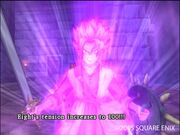Tension is a status effect in the Dragon Quest series. It was first introduced in Dragon Quest VIII and surrounds the user in an aura of malice, multiplying their strength for the next attack.
Previous Incarnations
In previous Dragon Quest games, there were skills that can increase damage on the next attack, like Psyche Up and Charge Up.
What is Tension?
Tension is a state of building up power to unleash in a future action. In Dragon Quest VIII, every party member has an option called Psyche Up found at the bottom right of the battle options. This allows the player to take a turn to build up tension. The more times tension is built, the more powerful the next action will be. There are four levels of tension, representing special multipliers that the next action will be: 5, 20, 50, and 100. The multipliers are: at 5 tension, an ability will do 1.7x as much. At 20 tension, 3x as much. At 50, 5x, and at 100, 7.5x as much.
For example, Yangus' normal attack will do ~100 damage to a Slime. In a state of 5 tension, Yangus will do ~170 to the slime. This boost is applied to base damage, meaning that characters who normally only do 1 damage to enemies may end up doing considerably more with tension applied.
It also works on magic: offensive, defensive, and healing as well.
Angelo's Multiheal spell will heal ~100 HP to everyone. In a state of 50 tension, it can heal ~500 HP to everyone.
Tension does not work on skills that do no damage nor is it depleted when using such skills, such as the Underpants Dance.
Maximum tension also provides a defensive buff, reducing damage by a certain percentage after defense reductions are calculated.
Once an action like attacking or spell casting uses tension, tension is returned to the normal level.
Some enemies also have the ability of building tension, making them tougher in battles.
Super High Tension

Super High Tension
Using Psyche Up normally, a party member can reach 50 tension without difficulty. However, there is a chance that a party member will not reach 100 tension, causing the action to fail. However, that party member doesn't lose the tension already built. When a character reaches 100 tension, their sprite animation may change and they can inflict extreme damage on enemies.
Other Ways of Building Tension
Besides Psyche Up, there are other ways of building Tension.
In Dragon Quest VIII, the Timbrel of Tension boosts everyone's tension level by one. The player could also use High Strung Cheese to boost everyone's tension level by one.
In Dragon Quest IX, the hero/heroine can gain the ability Egg On, building another party member's tension level by one. The ability Feel the Burn, obtained by maxing out the Gladiator's "Guts" skill, raises tension whenever the character is hit while in effect.
In the Dragon Quest Monsters: Joker games monsters must have the Pyscho trait to use the skill, likely so that scouting isn't made easy. Most monsters who psyche up in previous games such as Mischievous Moles will have this trait and use it very often. Its also worth noting that there is no chance of failing to reach 100 tension.
Restrictions
There are limits to Tension. Tension does not carry over after battle ends, with one exception: in Dragon Quest IX, the Martial Artist's Manual allows it to be retained as long as it is in the character's inventory. This, however, has two restrictions; the tension level is lowered by one (e.g, from 100 to 50, or 5 to nothing), and tension is lost regardless if the player enters a new map region.
Tension is lost if a character is put to sleep, paralyzed, cursed, disabled by something like War Cry, dispelled by Disruptive Wave, or defeated in battle.
